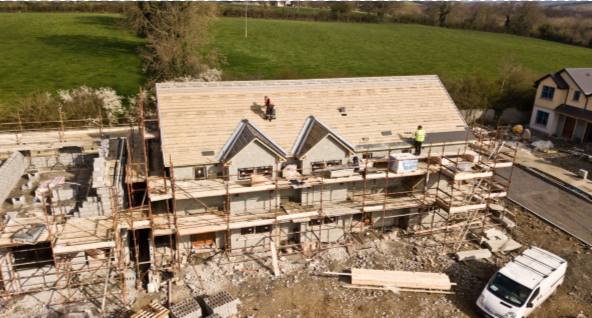
Like any industry, the construction industry comes with its own set of lingo and terminology unique to the field. The builder’s glossary will help you begin to understand and communicate construction concepts on the job site and across teams.
Construction design terms
On job sites, terms like “architectural drawings” and “blueprints” are ones you’ll hear often, especially if you are in construction management. Understanding their basic parts will help engineers, contractors, designers, and builders to execute the construction accurately.
- Architectural drawing: The technical rendering of a house or other structure that is both an illustration of what the final home will look like.
- Blueprints: Technical drawings created by architects, engineers, and designers that illustrate all the construction specifics of a house from below ground level, to the tallest ceiling.
- Elevations: Drawings that show the vertical layout of a building. An exterior elevation shows you what a house looks like if you’re standing front, next to, or behind it. An interior elevation shows the same but from inside.
- Reflected ceiling plan (RCP): A print that shows you the dimensions, materials, and other key information about the ceiling of each of the rooms represented on your blueprint.
- Sections (also known as “sectional views”): Drawings that show a vertical cross section of the structure and how the spaces inside fit together vertically.
- Site plan: An architeal document within a set of blueprints that functions as a readable map of a building site with details on how the structure will be oriented on the lot.
Structural Terms
Understanding the structural terms is the key to understanding the “why” behind blueprints and many other actions on the job site. If you love this terminology section, you may want to look into a career in construction engineering!
- Beams: Horizontal structural elements that can withstand vertical loads, shear, and bending moments. Wooden beams are more common in residential construction while steel beams are more common in large commercial construction projects.
- Box crib: A box crib is a temporary structure built much like a log cabin with alternating pieces of wood to form a structure that supports heavy objects during construction.
- Compression: When articles of a material are pushed against each other causing them to shorten, or compress.
- Cross bracing: When two beams are used to create a diagonal that helps reinforce the building. One beam is under compression while the other is under tension. This creates a greater ability for the structure to withstand lateral forces (like earthquakes).
- Decking: Decking is the section of the roof assembly which sits on top of the rafters or trusses and provides the structure or “deck” for the damp proofing and roofing layers.
- Floor sheathing: Commonly known as the sub-floor, this is a structural panel that is fastened to the floor structure.

Polyurethane adhesives, AKA general construction adhesives
Polyurethane glue entered the American market until 1994 when the Gorilla Glue company began selling polyurethane glues. (For many Americans, Gorilla Glue is the more familiar name for polyurethane than its chemical one.) Over the last two decades, it has become one of the most common go-to construction adhesives that contractors depend upon for all sorts of jobs. Popular brands include Titebond and Loctite.
Similar to cyanoacrylates, polyurethane adhesives require a chemical reaction. This will help in curing, and that reaction is set off by moisture.
If you’re gluing concrete to wood, no problem—concrete has moisture; wood’s got moisture. When one of the substances is non-porous, however, some extra moisture is required. Jordan recommends moistening one side of your joint using a little spritz bottle. Thereafter, apply glue to the other side and stick them together tight.
See the strength of polyurethane glue in action in Chapter 8, in which Jordan uses it to lift a car.









